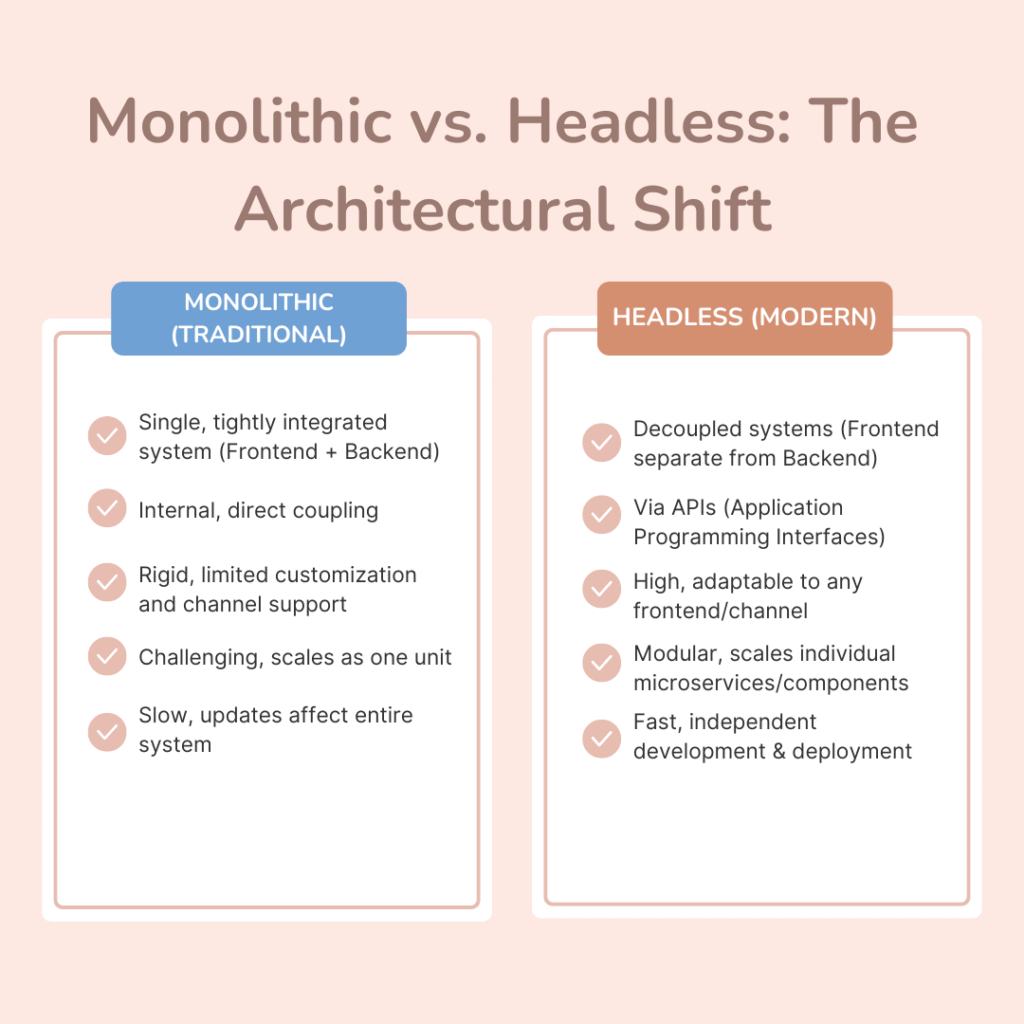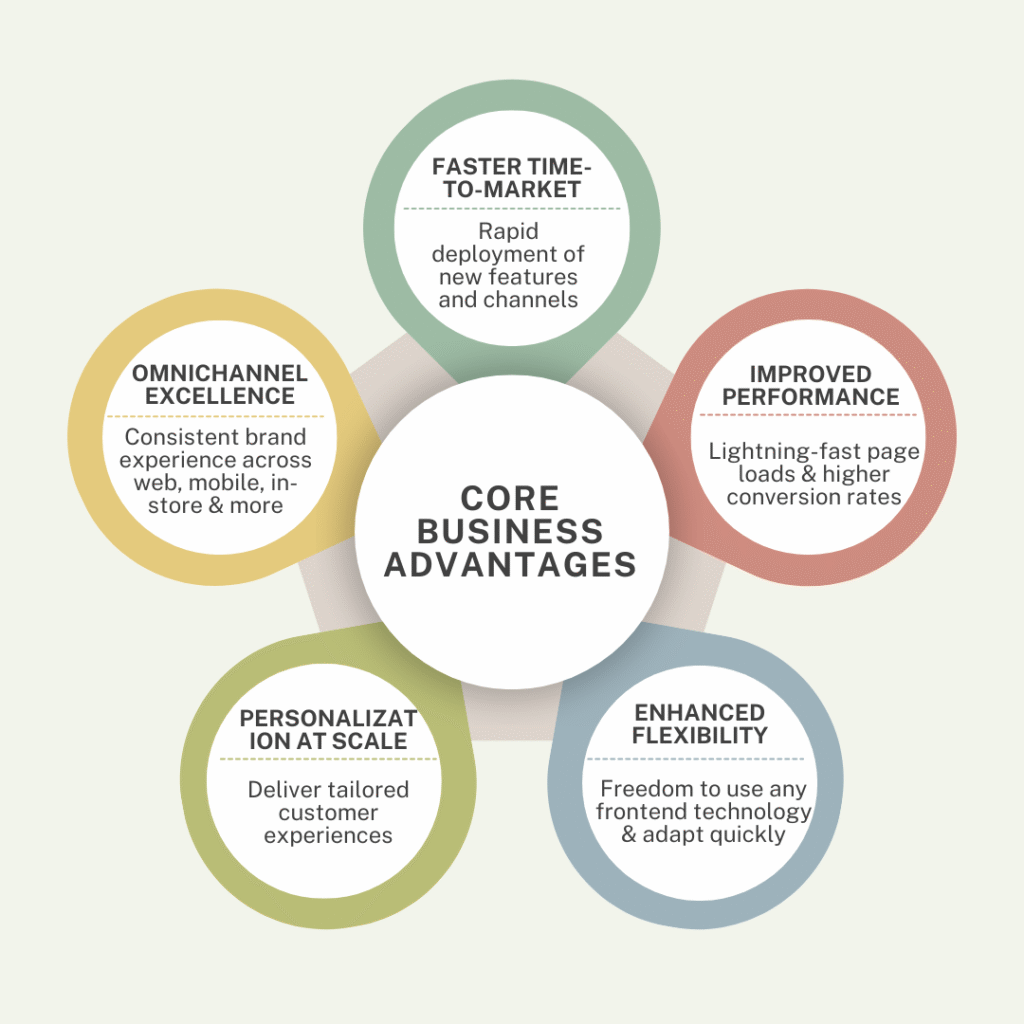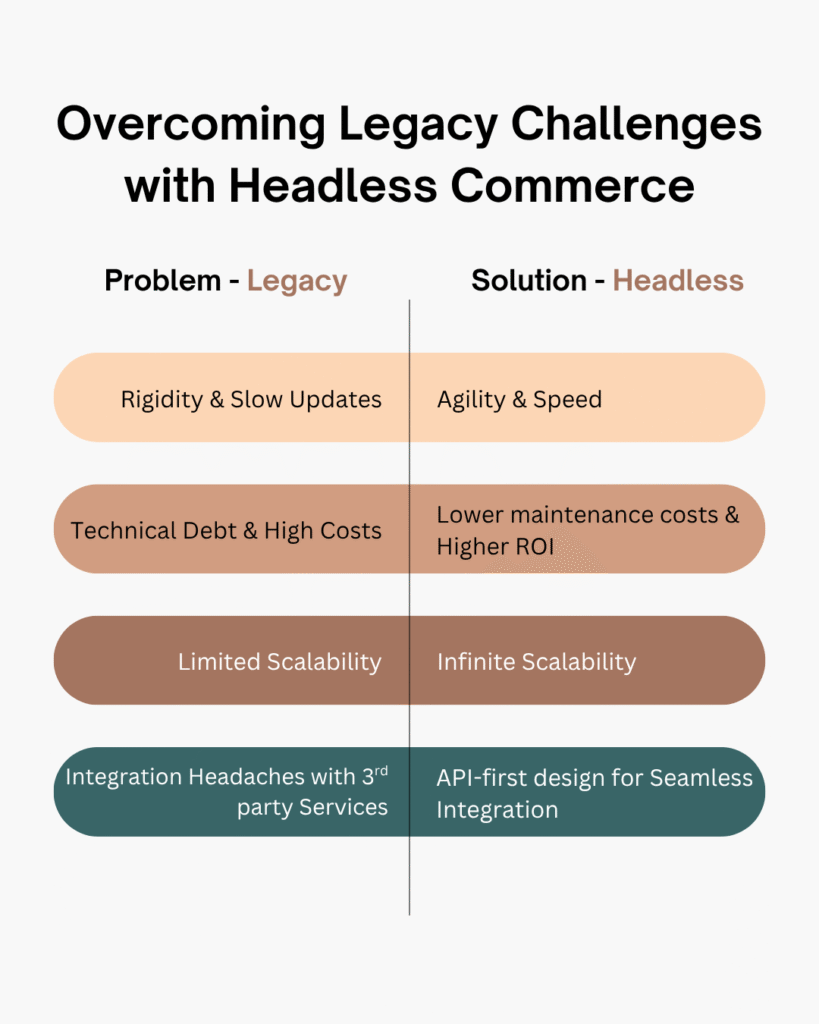Generative AI in Ecommerce : Unlock the Future of Business Success


Digital commerce is shifting rapidly. Traditional monolithic platforms, which facilitated online commerce, are now falling apart due to the new digital requirements. Customers now demand interactions to be customized to the minute detail, multi-channel, and instantaneous.
Legacy system businesses are facing a significant upcoming threat. Relying on the systems such businesses have been using is now a game-losing move. These businesses are operating with a system that is slowly removing them from the market.
In this article, we will understand how decoupling frontend and backend systems in eCommerce (also known as headless commerce) offers unparalleled flexibility, scalability, and personalized experiences, making it the future of eCommerce architecture.
Headless architecture works under a system that mandates that all capabilities are built and exposed via APIs from the groundwork. Such APIs would provide the business modularity, scalability, and reusability of systems. Developers are now empowered to build custom frontends using popular tools and frameworks as they become assured of the consistency of the backend. This change makes new products available faster and encourages creativity.
The API first approach is the cornerstone of headless commerce. Everything needs to be built and exposed through APIs, which adds flexibility, modularity, and reusability. With this approach, developers can use any framework or tool they like to create fully customized frontends. Apart from this, it also improves the development timelines and encourages creativity at various levels of interaction with the business and its systems.
Headless commerce platforms use a microservices architecture, which includes various complicated features of eCommerce broken down into smaller, more manageable components like inventory management or customer authentication. Each smaller section is a microservice that executes its specific function independently of any other service.
Traditional and headless commerce differ primarily in their underlying architecture and the adaptability each offers.
Traditional platforms follow a rigid monolithic eCommerce architecture, bundling all commerce layers into one system. Their designs integrate backend product information, order data, payment transactions, and the customer storefront into one dependent system. While this might make the initial setup easier, it often comes at the cost of flexibility and customization. On top of that, even minor changes to the frontend usually need backend updates too, which slows development and adds to both costs and technical debt.
Headless commerce differs greatly; it separates these layers. The frontend is separated from the backend. They talk only with APIs. This setup starts with APIs and gives organizations a lot of control. Developers may pick any front-end tool to make very special and fast user interfaces, as the back end works just on trade tasks. With this, businesses can really get creative with their brand experiences across different channels, since they’re not stuck with a single, all-in-one platform.

Headless eCommerce technology excels at delivering content through Static Site Generators (SSGs) and Content Delivery Networks (CDNs), which significantly improves the user experience as frontend applications pre-render pages and retrieve dynamic data via efficient API calls.
That’s not all! Headless commerce also makes it possible to build Progressive Web Apps (PWAs), giving users an app-like experience right from their browser.
Once features and integrations are worked into a traditional eCommerce system, it becomes cumbersome to work with, making eCommerce platforms a slow and costly maintenance project. With headless, this is taken care of as the focus is split between frontends and development backends. This architectural clarity reduces bugs, enhances stability during updates, and enables the gradual adoption of new technologies with minimal disruption.
A recent study indicates that using a Product Information Management (PIM) system can boost online conversions, including sales, by up to 50%. Headless commerce solves multiple problems by using the API, which acts as a powerful bridge to sync data between websites, stores, mobile and social apps, and other systems. Customers can change devices mid-journey, enjoy continuous pricing and inventory, and the experience is effortless.
Omnichannel marketing has powerful outcomes, yielding 494% higher order rates and 250% more purchases compared to single-channel efforts. Consistency in business rules is possible with headless commerce, which allows firms to control several channels from a single backend.
Retailers can operate and scale websites, mobile applications, voice interfaces, and even marketplaces concurrently, which creates consistent catalogs driving rapid customer-facing platform growth.
Headless commerce facilitates learning-driven personalization, which is tailored engagement that analyzes behavior, context, and history to recommend products in real-time. This aligns with the preference of over 90% of shoppers for personalized experiences. This customer-centered automated eCommerce architecture enhances intelligent interactions with users at every lifecycle stage, ensuring tailored engagement.

The practical applications of headless commerce demonstrate its transformative potential across diverse business scenarios. Architectural flexibility directly translates into tangible business advantages, as these use cases demonstrate.
Headless technology enables businesses to deliver exceptional experiences at every customer touchpoint. Businesses can develop multiple frontends using the same backend information. This enables native mobile applications, home AI devices, websites, and even point-of-sale (POS) systems to be utilized. Flexibility of this nature is critical in servicing the modern customer who expects seamless, uninterrupted experiences across all devices.
Various brands worldwide are making a shift towards a headless solution so that they can streamline their day-to-day operations and implement multi-device experiences. Some notable brands’ success stories include:

Equipped with modern web tools, API integration, and microservices architecture, development teams need to implement headless commerce. Organizations may need to invest in team training or partner with specialized development firms to ensure successful implementation. The complexity extends further into quality assurance and testing, which must address multiple frontend applications and backend services with comprehensive strategies.
Implementation of headless commerce requires the integration architecture to be well planned. The performance benchmarks, security measures, and scalability goals need to be captured during the planning stage. Creation of detailed integration blueprints with a roadmap, vital features for augmentation with additional details, further helps organizations.
A headless CMS makes it easier to roll out advanced content strategies like personalized messaging, A/B testing, and dynamic content delivery. But to get the most out of it, content teams will need to rethink how they work and adopt new processes.
Cost-Effective Expert Access
Competitive prices coupled with specialized expertise on headless commerce make offshore development teams an attractive proposition. The cross-border nature of headless commerce development means skilled professionals from anywhere in the world can effectively participate in projects.
Scalable Resource Allocation
Projects often require varying levels of development resources throughout the implementation and maintenance phases in a headless commerce approach. Costs and project expenses can be lowered through offshore partnerships that allow companies to add or remove project resources depending on project requirements.
Moving to a headless commerce setup require looking at the current system architecture in detail while also trying to analyze a few factors for the business, such as what is trying to be achieved, what the current structural readiness is, team readiness, and many other elements to determine the best path forward and a time estimate.

Businesses must evaluate their existing technological infrastructure and what new assets could be integrated. Businesses operating legacy systems that incorporate PostgreSQL or MySQL databases face an immediate scaling bottleneck that headless commerce systems can solve. These established frameworks struggle with something as basic to modern systems as real-time processing, which causes performance issues. Headless commerce is a viable option for organizations facing persistent downtimes, slow response times, or difficulty rolling out new features.
The return on investment (ROI) for headless commerce is robust and often achieved within 12 to 18 months. It improves innovation speed, significantly lowers technical debt and maintenance costs, and sustains legacy systems. The investment is well justified with positive returns on conversion rates, customer satisfaction, and efficiency, further proving its future-proof attributes. The outcomes are sustainable digital growth with measurable results.
The success of headless commerce relies greatly on strategic alignment with skilled teams. Leadership should focus on the transformation’s sustained value through a long-term lens. Organizations that have developers proficient in APIs, microservices, and other modern web technologies are better equipped. Others can leverage offshore teams to bridge the technical gaps and accelerate implementation with confidence and lower costs.
Before switching to headless commerce, some signs of readiness can be considered. Planning an expansion to new regions or considering the release of a mobile application are strong indicators. Headless eCommerce systems can assist businesses in providing uninterrupted experiences wherever customers engage with their solutions.
Revenue growth also points to this readiness. Business-first platforms, with their rigid and inefficient infrastructure, often struggle to accommodate seasonal demand spikes, rapid customer acquisition, and business expansion.
The shift to headless commerce isn’t just about technology; rather, it is a strategic imperative for businesses aiming for sustained competitive advantage. Most retailers are planning adoption in the next two years, and the projections seem to keep rising. The market is asking not whether you will go headless, but when and how effectively this will be done.
Adopting headless commerce systems streamlines operating processes and offers customer-facing benefits alongside new revenue streams. The shift to headless commerce offers more than a step up. It is a transformative shift in business strategy. It remains a critical requirement in fulfilling the great demands of eCommerce – a seamless ability to adapt to changing customers and market demands, which headless commerce satisfies.
Ready to scale your eCommerce operations in a headless way? You’re at the right place! RBM Software offers solutions in which outdated systems are reformed into modern headless systems of commerce that are scalable.
Schedule a free consultation today to assess your eCommerce architecture and explore how our headless commerce, microservices, and AI solutions can empower your business.